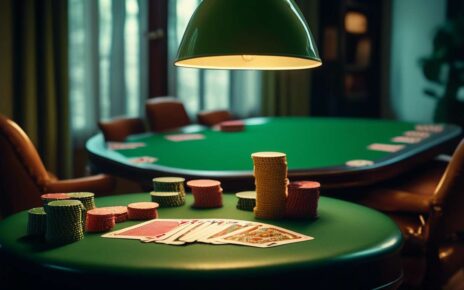When we first step into the world of blackjack, the vibrant hum of the casino and the allure of the green felt immediately captivate us. Together, we’re embarking on a journey to master the basics of this timeless card game, where strategy and chance intertwine.
As beginners, we often find ourselves intrigued by the challenge of beating the dealer. It’s this curiosity that drives us to understand the game better. In this article, we will explore the foundational elements of blackjack—from understanding card values to learning the essential strategies that will boost our confidence at the table.
By breaking down the core components, we aim to equip ourselves with the knowledge needed to make informed decisions, turning each hand into an opportunity for success.
Understanding Card Values:
- Number cards (2-10) are worth their face value.
- Face cards (Jack, Queen, King) are each worth 10 points.
- Aces can be worth either 1 or 11 points, depending on which value benefits your hand the most.
Essential Strategies:
- Basic Strategy: Learn when to hit, stand, double down, or split based on your hand and the dealer’s visible card.
- Card Counting: Although more advanced, this technique involves keeping track of high and low cards to gauge the probability of favorable outcomes.
By familiarizing ourselves with these elements, we empower ourselves with the skills necessary to play smarter and enjoy the experience to its fullest. As we delve into the world of blackjack, let’s embrace each hand as an opportunity to refine our strategy and savor the excitement of the game.
Card Values
In blackjack, understanding the value of each card is crucial for calculating your hand’s total and making strategic decisions.
Card Values:
-
Cards numbered 2 through 10 are worth their face value.
- Example: If you have a 7 and a 5, your total is 12.
-
Face cards—Jacks, Queens, and Kings—are each valued at 10.
- Example: Pairing a King with a 4 results in a hand totaling 14.
-
The Ace is the most versatile card, valued at either 1 or 11, depending on what benefits you the most.
- Example: If you draw an Ace and a 9, you have a "soft 20," providing flexibility if you decide to take another card.
Importance of Understanding Card Values:
Grasping these card values is essential as you learn to play blackjack. It helps you:
-
Connect with Fellow Players: Sharing a common understanding of the game enhances the social experience.
-
Strategize Effectively: Knowing your hand’s total and potential can guide your decisions on whether to hit, stand, or take other actions.
-
Enjoy the Game: With a solid foundation in card values, you can fully immerse yourself in the excitement and challenge of blackjack.
Basic Strategy
A solid grasp of basic strategy can significantly improve our odds of winning in blackjack by guiding us on when to hit, stand, double down, or split. It acts as our roadmap, helping us navigate the game confidently and make decisions that align with the probabilities. By following basic strategy, we join a community of players who understand that blackjack is more than just chance; it’s about making informed choices.
For those of us just learning how to play blackjack, basic strategy involves understanding key concepts:
- Always pay attention to the dealer’s upcard, as it holds vital clues about our next move.
- Double down on hands like 11.
- Split pairs like aces and eights.
By following these guidelines, we maximize potential winnings and minimize losses.
Together, as we embrace this approach, we build a sense of camaraderie, knowing we’re making smart decisions that connect us to seasoned players worldwide.
Hit or Stand
Deciding Whether to Hit or Stand
Deciding whether to hit or stand is a crucial aspect of our blackjack strategy, as it directly influences our chances of beating the dealer. As we dive into how to play blackjack for beginners, understanding this decision-making process is key.
When to Stand:
If the dealer shows a weak card, such as:
- 4
- 5
- 6
we often stand on a total of 12 or higher, hoping the dealer will bust.
When to Hit:
If the dealer has a strong card like:
- 7
- 8
- 9
- 10
hitting might be our best move unless we hold a high total ourselves.
Community and Shared Wisdom
Together, we rely on our community’s shared wisdom and collective experiences to make informed choices. It’s comforting to know that we’re not alone in this journey.
Our decisions are rooted in solidarity and shared strategies, making blackjack more than just a game; it’s a shared experience.
Continuous Learning
Let’s keep honing our skills, learning from each other, and enjoying every step of our blackjack adventure.
Double Down
Doubling down is an exciting move that allows us to double our initial bet in exchange for committing to stand after receiving just one additional card. This move adds a thrilling layer to our blackjack strategy and can significantly boost our winnings.
Key Considerations for Doubling Down:
-
For beginners learning how to play blackjack, knowing when to double down is crucial.
-
Generally, consider doubling down when:
- You have a total of 10 or 11.
- The dealer shows a weaker card, such as a 5 or 6.
This strategy puts us in a strong position to hit a high card and secure a win.
Timing and Strategy:
-
Timing is everything; understanding the basic strategy is crucial.
-
Community Learning:
- As a community of blackjack enthusiasts, sharing tips on when to double down can enhance our collective success.
-
Risk Assessment:
- While doubling down is a powerful tool, it’s also a gamble.
- Always assess the table dynamics and use this move wisely.
Responsible Play:
- Ensure that we play confidently and responsibly, taking into account the risks involved with doubling down.
Splitting Pairs
Splitting Pairs in Blackjack
Splitting pairs is a strategic move in blackjack that allows players to turn one hand into two when dealt two cards of the same value. This strategy offers a chance to maximize winnings and can be a game-changer for beginners learning how to play blackjack. By making informed decisions about when to split, players can potentially double their success and feel more engaged with the game and fellow players.
How to Split Pairs
When dealt two cards of equal rank, such as two eights or two nines, players have the option to split them into two separate hands. Here’s how it works:
- Split the Cards: Separate the pair into two individual hands.
- Place an Additional Bet: Add an additional wager equal to the original bet on the new hand, effectively doubling the stake.
When to Split
Splitting can be particularly advantageous when the dealer shows a weak card. However, knowing which pairs to split is crucial:
-
Pairs to Split:
- Eights
- Aces
-
Pairs to Avoid Splitting:
- Tens
- Face cards
Understanding these guidelines not only enhances gameplay but also helps players feel more connected to the blackjack community and closer to mastering the game.
Aces in Blackjack
Aces in Blackjack
Aces in blackjack are versatile cards since they can be valued at either one or eleven, giving us strategic flexibility in our gameplay. As we learn how to play blackjack for beginners, understanding the power of an ace is crucial.
Blackjack and Winning
- When we’re dealt an ace alongside a ten-value card, we’ve hit blackjack, the best possible hand.
- This combination rewards us with a win unless the dealer matches it.
Strategic Flexibility with Aces
- When holding an ace, we have the opportunity to adjust our strategy based on the other cards in our hand.
- For instance, if we’ve got an ace and a six, our hand can be worth either seven or seventeen.
- This flexibility allows us to make choices that can prevent us from busting or improve our standing against the dealer.
Playing Together
Remember, when playing together as beginners, having a supportive group helps us make confident decisions.
Mastering Aces
Aces are our allies in this exciting journey, and with practice, we’ll master their potential, feeling like a true part of the blackjack community.
Card Counting Basics
Card counting is a valuable skill that can tip the odds in our favor when playing blackjack. As we dive into how to play blackjack for beginners, it’s important to note that card counting isn’t about keeping track of each card. Instead, we’re estimating whether the remaining deck is favorable to players or the dealer.
How Card Counting Works:
By assigning values to cards, we can maintain a running count:
- +1 for cards 2 through 6
- 0 for 7 through 9
- -1 for 10 through Aces
When the count is high, it means more high cards are left, which is good for us. This information helps us make better decisions on our bets.
Key Points to Remember:
- It’s a team effort; we’re all in this together, learning and improving.
- While card counting requires practice and focus, it’s a rewarding technique that enhances our understanding and enjoyment of the game.
Let’s stay connected and keep honing our skills!
Probability in Blackjack
Understanding probability in blackjack allows us to make informed decisions by evaluating the likelihood of different outcomes during the game. It’s like being part of an exclusive club where we all share the secrets of success.
As we learn how to play blackjack for beginners, grasping the concept of probability helps us feel more connected to the game and each other. We’re not just playing blindly; we’re making choices that align us with the odds.
In blackjack, every card dealt changes the probabilities of future hands. For example, if we’ve seen several high-value cards, there are fewer left in the deck, which might affect our strategy. Knowing when to:
- Hit
- Stand
- Double down
hinges on these probabilities and keeps us engaged with the game.
By understanding probability, we’re not only improving our chances of winning but also deepening our connection with fellow players. This shared knowledge contributes to the excitement and camaraderie that blackjack offers.
What is the history and origin of the game of Blackjack?
Blackjack has an intriguing history, originating from a game called "Twenty-One."
Historical Background:
- It gained popularity in French casinos in the 18th century before evolving into the game we know today.
Objective:
- The objective remains the same: to beat the dealer without exceeding 21 points.
Popularity:
- Our love for this classic game is rooted in its simplicity and excitement, making it a timeless favorite among players worldwide.
How does the etiquette of playing at a Blackjack table work?
When we’re at a Blackjack table, we always make sure to follow the proper etiquette. It’s important to respect the dealer and other players by not being disruptive or rude.
Some key practices include:
- Keeping our cell phones away.
- Avoiding giving unsolicited advice.
- Staying focused on our own game.
- Acting with courtesy towards everyone at the table.
By following these guidelines, we create a pleasant atmosphere for everyone involved.
What are the differences between various Blackjack table rules in different casinos?
When it comes to the differences between various Blackjack table rules in different casinos, it’s crucial to pay attention to details. These differences can impact your strategy and overall gameplay experience.
Key Rule Variations:
-
Dealer Actions on Soft 17:
- Some tables require the dealer to hit on a soft 17, while others require standing. This can significantly affect the house edge and your strategy.
-
Doubling Down Options:
- Rules on when you can double down vary. Some tables allow doubling down on any two cards, while others restrict it to certain totals, like 9, 10, or 11.
-
Blackjack Payouts:
- The standard payout for a natural blackjack is 3:2. However, some tables offer 6:5 or even 1:1, which can greatly reduce your potential winnings.
Strategies for Success:
-
Stay Informed:
- Before playing, always check the specific rules of the table as they can differ even within the same casino.
-
Adapt Your Strategy:
- Adjust your gameplay based on the rules, such as being more conservative or aggressive depending on the doubling down options and dealer actions.
By staying informed and adapting to the specific rules of each table, you can maximize your chances of success and enjoyment.
Conclusion
Now that you’ve learned the basics of blackjack, you’re well on your way to becoming a skilled player. Remember to practice and master the strategies discussed in this article.
By understanding key elements such as:
- Card values
- Basic strategy
- Key moves like:
- Hitting or standing
- Doubling down
- Splitting pairs
you can improve your chances of winning at the table.
Keep honing your skills and enjoy the thrill of playing this classic casino game!




